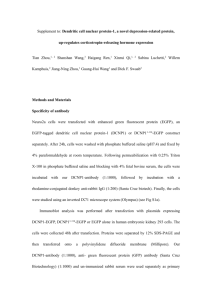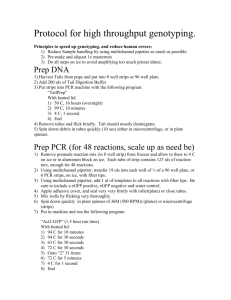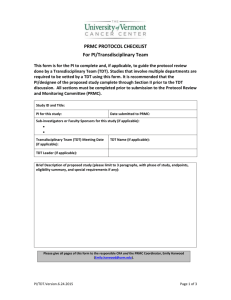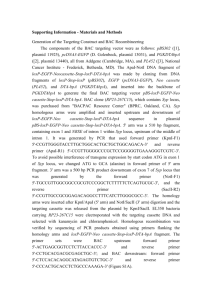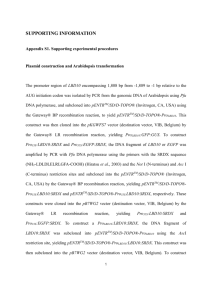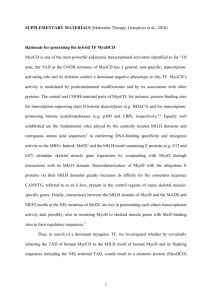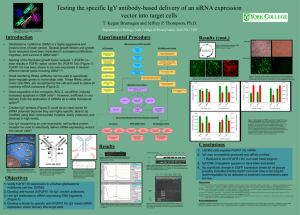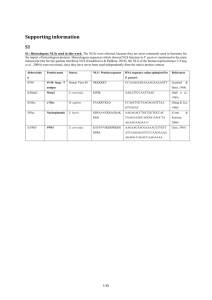nT-nG paper, 2013, supplement Supplemental Fig. S1 ROSAnT
advertisement
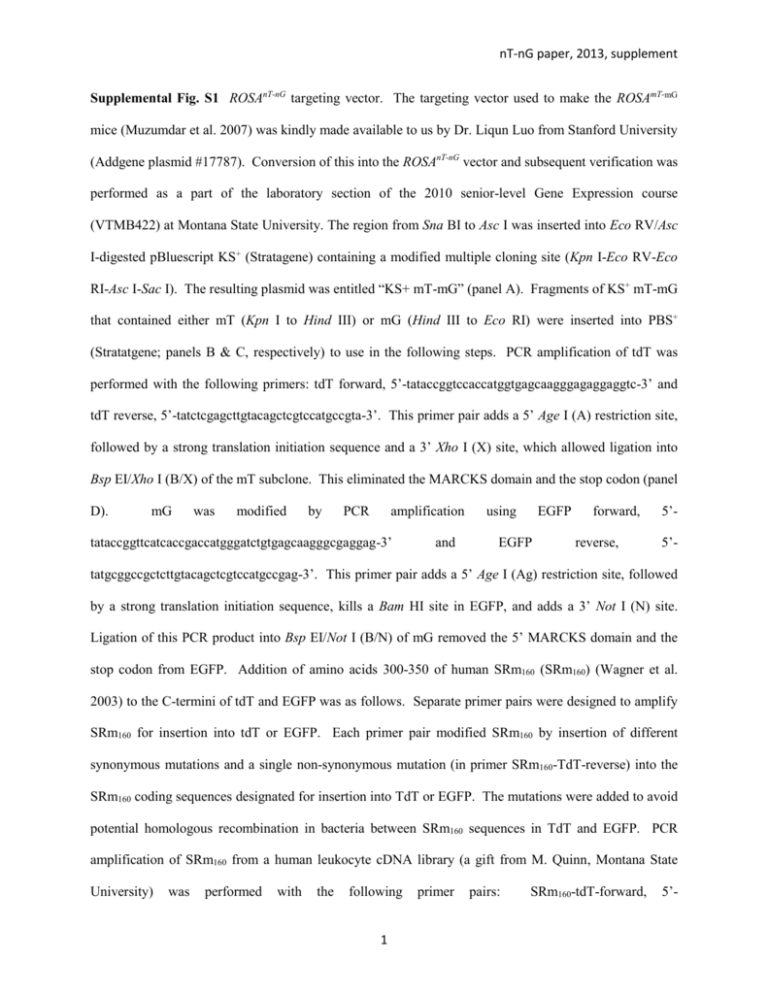
nT-nG paper, 2013, supplement Supplemental Fig. S1 ROSAnT-nG targeting vector. The targeting vector used to make the ROSAmT-mG mice (Muzumdar et al. 2007) was kindly made available to us by Dr. Liqun Luo from Stanford University (Addgene plasmid #17787). Conversion of this into the ROSAnT-nG vector and subsequent verification was performed as a part of the laboratory section of the 2010 senior-level Gene Expression course (VTMB422) at Montana State University. The region from Sna BI to Asc I was inserted into Eco RV/Asc I-digested pBluescript KS+ (Stratagene) containing a modified multiple cloning site (Kpn I-Eco RV-Eco RI-Asc I-Sac I). The resulting plasmid was entitled “KS+ mT-mG” (panel A). Fragments of KS+ mT-mG that contained either mT (Kpn I to Hind III) or mG (Hind III to Eco RI) were inserted into PBS+ (Stratatgene; panels B & C, respectively) to use in the following steps. PCR amplification of tdT was performed with the following primers: tdT forward, 5’-tataccggtccaccatggtgagcaagggagaggaggtc-3’ and tdT reverse, 5’-tatctcgagcttgtacagctcgtccatgccgta-3’. This primer pair adds a 5’ Age I (A) restriction site, followed by a strong translation initiation sequence and a 3’ Xho I (X) site, which allowed ligation into Bsp EI/Xho I (B/X) of the mT subclone. This eliminated the MARCKS domain and the stop codon (panel D). mG was modified by PCR amplification tataccggttcatcaccgaccatgggatctgtgagcaagggcgaggag-3’ and EGFP using EGFP forward, reverse, 5’5’- tatgcggccgctcttgtacagctcgtccatgccgag-3’. This primer pair adds a 5’ Age I (Ag) restriction site, followed by a strong translation initiation sequence, kills a Bam HI site in EGFP, and adds a 3’ Not I (N) site. Ligation of this PCR product into Bsp EI/Not I (B/N) of mG removed the 5’ MARCKS domain and the stop codon from EGFP. Addition of amino acids 300-350 of human SRm160 (SRm160) (Wagner et al. 2003) to the C-termini of tdT and EGFP was as follows. Separate primer pairs were designed to amplify SRm160 for insertion into tdT or EGFP. Each primer pair modified SRm160 by insertion of different synonymous mutations and a single non-synonymous mutation (in primer SRm160-TdT-reverse) into the SRm160 coding sequences designated for insertion into TdT or EGFP. The mutations were added to avoid potential homologous recombination in bacteria between SRm160 sequences in TdT and EGFP. PCR amplification of SRm160 from a human leukocyte cDNA library (a gift from M. Quinn, Montana State University) was performed with the following 1 primer pairs: SRm160-tdT-forward, 5’- tatgtcgaccggcggcatagatcagataaaatgtattcaccaagaaggcgaccaagtccaagaagacggccatct-3’ and SRm160-tdT- reverse, 5’-tatgtcgacttatgaacgtcttcgtcgcctatctggcgatctgctccttctgtgccttgggggaggaggcatccttct-3’. SRm160- EGFP-forward, 5’-tatcggccgacgccataggtccgacaagatgtactcacctcgaaggcggcctagcccacgaaggcggccatct-3’ and 5’- SRm160-EGFP-reverse, tatgtcgacttaggaacgtctccttcgtctaactggagacctactccttcgatgcctcggtggcggaggcattcttct-3’. The SRm160-tdT primer pair adds a 5’ and 3’ Sal I (S) site to SRm160, allowing in-frame insertion into Xho I at the Cterminus of tdT (panel D). The SRm160-EGFP primer pair adds a 5’ Eag I (E) and 3’ Sal I site to SRm160. Eag I/Sal I-digested SRm160 was ligated into Not I/Xho I-digested EGFP (panel E). These plasmids contain the nT and nG portions of the new targeting vector (panels D&E). Hind III/Eco RI (H/RI) nG was inserted between Hind III and Eco RI sites in KS+ mT-mG, which produced KS+ mT-nG (panel F). Kpn I/Hind III (K/H) nT was inserted between Kpn I and Hind III in KS+ mT-nG, which produced KS+ nT-nG (panel G). Finally, a fragment of KS+ nT-nG from Sgr AI (Sg) to Asc I (As), which encompassed all modifications of the original mT-mG to nT-nG sequence (panel G) was inserted into the ROSAmT-mG targeting vector between Sgr AI and Asc I, replacing mT-mG with nT-nG to generate the ROSAnT-nG targeting vector. To biologically verify the expression and subcellular localization of fluorescent markers encoded on these plasmids, the clones depicted in panels A, D, F, and G were transiently transfected into COS7 cells, the cells were then transduced with a replication-defective adenoviral vector encoding Cre (AdCre) to express Cre in a subset of the transiently transfected cells. Cells were photographed by fluorescence microscopy 2 days later (panels H – J and data not shown). In all panels, the blue fluorescence is Hoechst’s stained nuclei; red fluorescence is expression of the un-recombined (Cre-naïve) allele; and green fluorescence is expression of the Cre-recombined allele. All of the plasmids depicted or described here are available on request unless specifically restricted by another party. The final targeting vector was linearized with Kpn I for electroporation into ES cells. One-hundred-fifty-two (152) G418resistant colonies were selected and analyzed, of which eight contained a correctly targeted version of the entire cassette. One clone was selected for mouse production. Male chimeras were bred to wild-type C57Bl/6 dams and pups bearing the ROSAnT-nG allele were selected as founders. Founders (ROSAnT-nG/+) 2 nT-nG paper, 2013, supplement were bred to C57Bl/6 mice to establish the line. (K) Genotyping of a litter of a founder x C57Bl/6 mouse is shown for a reaction that verifies targeted insertion (upper panel; primers “Rosa3” and “Rosa4” as described previously: (Zong et al. 2005)) and a reaction that detects EGFP (lower panel; EGFP-forward, 5’-tagaattcatctgcaccaccggcaagctgc-3’ and EGFP-reverse, 5’-agaaagcttgtgccccaggatgttgccg-3’). Pups 1, 3, 4, and 5 were ROSAnT-nG/+; pups 2, 6, and 7 were ROSA+/+. Muzumdar MD, Tasic B, Miyamichi K, Li L, Luo L. 2007. A global double-fluorescent Cre reporter mouse. Genesis 45: 593-605. Wagner S, Chiosea S, Nickerson JA. 2003. The spatial targeting and nuclear matrix binding domains of SRm160. Proc Natl Acad Sci U S A 100: 3269-3274. Zong H, Espinosa JS, Su HH, Muzumdar MD, Luo L. 2005. Mosaic analysis with double markers in mice. Cell 121: 479-492. 3
